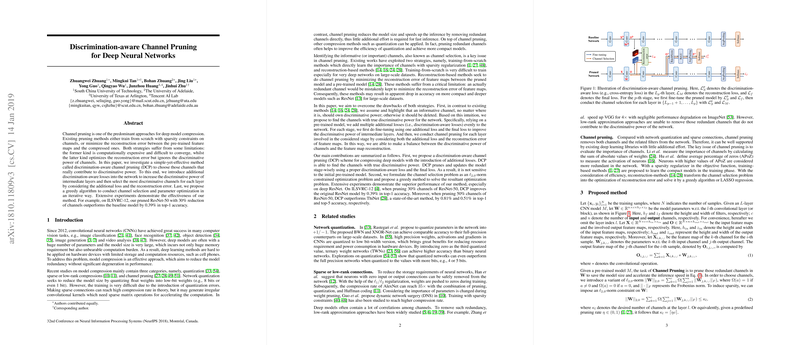Discrimination-Aware Channel Pruning for Deep Neural Networks
The paper introduces a method called Discrimination-aware Channel Pruning (DCP) aimed at enhancing deep neural network compression techniques. Unlike existing approaches that either impose sparsity constraints from scratch or minimize reconstruction errors between original and compressed models, DCP prioritizes identifying channels that contribute significantly to a network’s discriminative power.
Overview
Channel pruning is well-regarded for reducing model size and computational cost by removing redundant channels. However, conventional methods often face challenges. Training-from-scratch is computationally heavy and prone to convergence issues, while reconstruction-based strategies may retain non-informative channels due to their focus on minimizing feature map errors.
DCP proposes a different tactic by integrating discrimination-aware losses into intermediate layers of the network. This integration is designed to fine-tune the network and focus on maintaining its discriminative abilities. By feeding additional losses and combining them with reconstruction errors, the method balances network compression with preserving accuracy.
Methodology
- Discrimination-Aware Loss: DCP inserts supplementary loss functions at various layers to increase the discriminative strength of intermediate outputs. This is achieved through a combination of softmax cross-entropy losses and mean squared errors.
- Greedy Channel Selection: An -norm constrained optimization identifies informative channels. A greedy algorithm iteratively selects channels that most improve the discrimination-aware objective.
- Stage-Wise Process: The network is updated iteratively, fine-tuning with respect to nascent loss functions and fine-tuning the structural parameters accordingly.
Experimental Results and Reliability
Extensive experiments on datasets like CIFAR-10 and ILSVRC-12 demonstrate DCP's efficacy. Notable results include a pruned ResNet-50 model that, despite a 30% reduction in channels, improves top-1 accuracy by 0.39%. On CIFAR-10, VGGNet achieved a 15.58× reduction in model size while outperforming its original version.
Implications and Future Work
DCP presents an efficient channel pruning solution that effectively trims models without compromising accuracy. It is adaptive, supporting the automatic determination of pruning rates by observed stopping conditions, offering a substantial reduction in model size while maintaining performance standards.
The research points towards future exploration in combining DCP with other compression techniques, such as quantization, to achieve further reductions in model size and computational overhead.
Conclusion
DCP effectively highlights the importance of discriminative power in neural network compression. Its balanced approach to channel selection preserves the integrity and performance of deep neural networks, facilitating deployment on resource-constrained devices like smartphones. The introduction of discrimination-aware losses provides pathways for more fine-grained control over model compression and hints towards promising developments in efficient neural network design.
